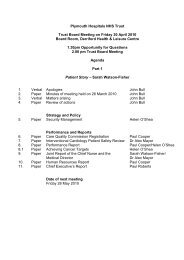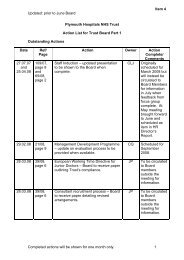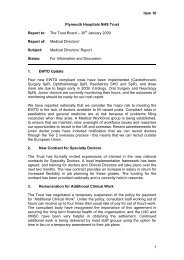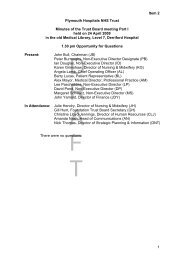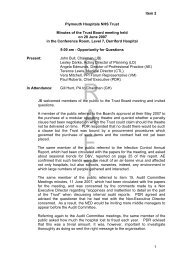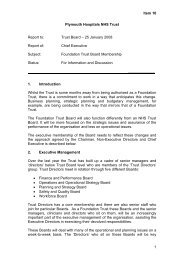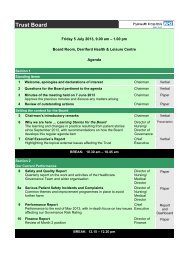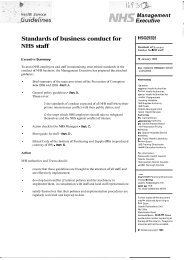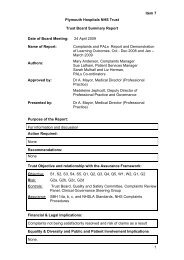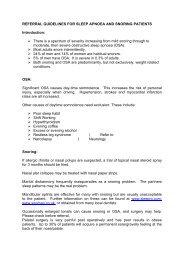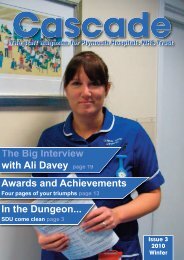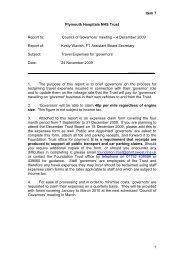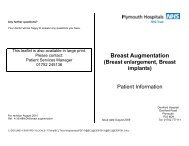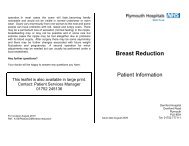Minutes of the Clinical Governance Committee meeting, 16 ...
Minutes of the Clinical Governance Committee meeting, 16 ...
Minutes of the Clinical Governance Committee meeting, 16 ...
Create successful ePaper yourself
Turn your PDF publications into a flip-book with our unique Google optimized e-Paper software.
Item 10<br />
Plymouth Hospitals NHS Trust<br />
Trust Board Summary Report<br />
Date <strong>of</strong> Board Meeting: 31 October 2008<br />
Name <strong>of</strong> Report: <strong>Clinical</strong> <strong>Governance</strong> <strong>Committee</strong> <strong>Minutes</strong> Sept 08<br />
Authors:<br />
Approved by:<br />
Presented by:<br />
Dr Peter Glew, Associate Medical Director for<br />
<strong>Clinical</strong> <strong>Governance</strong><br />
Pr<strong>of</strong>essor John Bull, Chairman<br />
Pr<strong>of</strong>essor John Bull, Chairman<br />
Purpose <strong>of</strong> <strong>the</strong> Report:<br />
To update <strong>the</strong> Trust Board on clinical governance issues discussed and<br />
agreed at <strong>the</strong> <strong>16</strong> th September 2008 <strong>Clinical</strong> <strong>Governance</strong> <strong>Committee</strong> <strong>meeting</strong><br />
encompassing <strong>the</strong> following:<br />
• Fractured Neck <strong>of</strong> Femur Update – improved August figures <strong>of</strong> 89%<br />
attributed to additional <strong>the</strong>atre capacity<br />
• NICE Action Plan for CG47 Febrile illness in Children - issues included<br />
limited junior doctor training, partly due to funding and lack <strong>of</strong> a release<br />
mechanism<br />
• NICE Implementation Compliance Report - 84% compliance had been<br />
achieved, large number <strong>of</strong> unknowns against audit to be monitored closely<br />
• NICE Implementation Team Terms <strong>of</strong> Reference approved<br />
• NSF Implementation Process approved<br />
• NSF Compliance Bi-Annual Report - new lead for Children & Young<br />
People’s NSF and Maternity NSF, improvements in progress were<br />
expected<br />
• Medical Device Training Report - 5 main recommendations discussed and<br />
supported<br />
• New Interventional Procedure – Total Wrist Replacement presented and<br />
approved subject to a business case<br />
• New Interventional Procedure – Transca<strong>the</strong>ter Aortic Valve Implantation<br />
presented and approval was given for <strong>the</strong> clinical aspect <strong>of</strong> <strong>the</strong> procedure<br />
• CEMACH – update report given, Trust is mainly on target for<br />
recommendations, training issues highlighted<br />
• Review <strong>of</strong> Incident Reporting System – agreed numbers <strong>of</strong> incidents in<br />
holding area to be included in <strong>the</strong> monthly performance reviews<br />
• Policies – Training Needs Analysis, Safeguarding Adults Policy, <strong>Clinical</strong><br />
Record Keeping Policy and Report Aggregation Statement were approved<br />
1
Item 10<br />
Action Required:<br />
The Trust Board is asked to note <strong>the</strong> attached minutes and actions taken.<br />
Recommendations:<br />
None<br />
Relationship with <strong>the</strong> Assurance Framework (Risks, Controls and<br />
Assurance, Annual Health Check):<br />
Provides an update on clinical governance activities, which directly impact on<br />
Standards for Better Health and Annual Health Check.<br />
Summary <strong>of</strong> Financial & Legal Implications:<br />
None<br />
Equality & Diversity and Public and Patient Involvement Implications<br />
Both equality & diversity and patient & public involvement are well<br />
represented on <strong>the</strong> <strong>Clinical</strong> <strong>Governance</strong> Steering Group, which reports<br />
through <strong>the</strong> <strong>Clinical</strong> <strong>Governance</strong> <strong>Committee</strong>.<br />
2
Item 10<br />
Plymouth Hospitals NHS Trust<br />
<strong>Clinical</strong> <strong>Governance</strong> <strong>Committee</strong><br />
Tuesday <strong>16</strong> th September 2008 at 12.00 – 14.00<br />
Cardiac Meeting Room Level 9<br />
Draft <strong>Minutes</strong><br />
Present: Pr<strong>of</strong>essor John Bull (JB) Chairman<br />
Tony Beecher (TB) Non Executive Director<br />
Craig Bibby (CB) Risk Manager<br />
Peter Glew (PG) Associate Medical Director for <strong>Clinical</strong><br />
<strong>Governance</strong><br />
Jayne Glynn (JG) <strong>Clinical</strong> <strong>Governance</strong> Support Manager<br />
Madeleine Jephcott (MJ) Deputy Director <strong>of</strong> Pr<strong>of</strong>essional Practice<br />
Alex Mayor (AM) Medical Director (Pr<strong>of</strong>essional Practice)<br />
Paul Roberts (PR) Chief Executive<br />
In<br />
Attendance:<br />
Kerri West<br />
Helmy Fekry (HF)<br />
Susan Loxdale (SL)<br />
Rachel Howells (RH)<br />
Victoria Daley (VD)<br />
Andy Nevill (AN)<br />
Ian Cox (IC)<br />
Sarah Fitzpatrick (SF)<br />
Anne Bussell (AB)<br />
<strong>Minutes</strong><br />
Consultant Orthopaedic Surgeon<br />
Consultant Anaes<strong>the</strong>tist<br />
Consultant Paediatrician<br />
Educ. Development Pract. Equip. &<br />
<strong>Governance</strong><br />
Director <strong>of</strong> Healthcare Science &<br />
Technology<br />
Consultant Cardiologist<br />
<strong>Clinical</strong> Risk Manager Maternity<br />
Head <strong>of</strong> <strong>Clinical</strong> Records & Knowledge<br />
Services<br />
1. Apologies<br />
Apologies were received from Louise Hardy, Peter Jenks, Angela Lamb,<br />
David Edwards and Matt Prior.<br />
Action<br />
2. <strong>Minutes</strong> and Matters Arising<br />
<strong>Minutes</strong> <strong>of</strong> <strong>the</strong> last <strong>meeting</strong> were agreed as a true and accurate record. The<br />
<strong>Committee</strong> were asked to note that unfortunately due to a change in<br />
administrative support a fully comprehensive set <strong>of</strong> minutes were unavailable.<br />
3. Review <strong>of</strong> Actions<br />
JB took <strong>the</strong> <strong>Committee</strong> through a review <strong>of</strong> <strong>the</strong> action table.<br />
4. Briefing from <strong>the</strong> Associate Medical Director for <strong>Clinical</strong> <strong>Governance</strong><br />
4.1 Fractured Neck <strong>of</strong> Femur Update<br />
Helmy Fekry briefly outlined <strong>the</strong> Fractured Neck <strong>of</strong> Femur Pathway and<br />
handed over to Sue Loxdale who gave a presentation detailing <strong>the</strong> current<br />
position. SL explained <strong>the</strong>re are three quality Indicators:- Post-Operative<br />
Length <strong>of</strong> stay, Length <strong>of</strong> Stay and Readmissions. The current length <strong>of</strong> stay<br />
CGC <strong>Minutes</strong> Draft September 2008 – ver 2<br />
3
timescale <strong>of</strong> eight days was considered to be unrealistic.<br />
Item 10<br />
Benchmark evidence had been ga<strong>the</strong>red from ‘Warwick University Length <strong>of</strong><br />
Stay Hospital Episodes Statistics for 2005/6’, two categories were considered<br />
‘spells’ and ‘super spells’. Spells were explained as admission until medically<br />
discharged which on average was 15 days and super spells which included<br />
rehabilitation and community care on average was 21 days. Difficulties<br />
ga<strong>the</strong>ring performance data sets was highlighted, it was agreed PG would<br />
write to Paul Cooper highlighting <strong>the</strong> current difficulties with data collection for<br />
Orthopaedics and ask him to work with <strong>the</strong> directorate to find a solution.<br />
PG<br />
Recent changes have improved <strong>the</strong> FNoF Pathway including:<br />
• Pre-op echocardiograms; which have significantly reduced time to <strong>the</strong>atre<br />
delays, <strong>the</strong> portable machines has meant <strong>the</strong>re are no longer cancellations<br />
due to no echocardiogram<br />
• Changes to <strong>the</strong> Anticoagulation (Clopidogrel) Policy have <strong>the</strong> eliminated<br />
<strong>the</strong> need for 5 day wait<br />
• Orthogeriatrician appointment<br />
HF pointed out that shortening pre-operative stay reduced <strong>the</strong> length <strong>of</strong> stay<br />
post-operatively. Consideration was given to allocating <strong>the</strong> first two slots on<br />
<strong>the</strong>atre lists to FNoF, SL felt <strong>the</strong>re was no spare capacity on current lists and<br />
<strong>the</strong>refore suggested a stand alone list. Consideration was given to <strong>the</strong><br />
practicalities <strong>of</strong> running <strong>the</strong> fracture neck <strong>of</strong> femur service.<br />
August figures for treatment within 48 hours improved to 89%, a huge<br />
improvement on <strong>the</strong> average 50-60%, this was attributed to additional<br />
capacity in elective <strong>the</strong>atres. HF felt <strong>the</strong>re was still room for improvement<br />
particularly with additional <strong>the</strong>atre capacity. AM pointed out fit to discharge<br />
was different to actual discharge due to availability <strong>of</strong> community care.<br />
The current 13% mortality rate was considered too high and SL was in <strong>the</strong><br />
process <strong>of</strong> examining <strong>the</strong> relevant notes in more detail to ascertain why.<br />
SL and HF were commended for identifying problems with <strong>the</strong> FNoF pathway<br />
and highlighting solutions, and felt it was clear <strong>the</strong> limiting factor was <strong>the</strong>atre<br />
capacity. HF suggested running two fur<strong>the</strong>r trauma lists which would reduce<br />
<strong>the</strong> total length <strong>of</strong> stay by 2/3 days and provide an overall increase in <strong>the</strong>atre<br />
capacity. AM highlighted <strong>the</strong> <strong>the</strong>atre efficiency work being undertaken by<br />
Richard Best and suggested contacting him for fur<strong>the</strong>r advice.<br />
It was agreed SL and HF would present <strong>the</strong>ir report along with a business<br />
plan to <strong>the</strong> next Quality & Safety Board <strong>meeting</strong> scheduled for 6 th October.<br />
AM felt <strong>the</strong> issues raised should be considered as a community and<br />
suggested forming a Darzi Group to discuss unplanned care. It was agreed<br />
James Palmer and AM would facilitate <strong>the</strong> formation <strong>of</strong> such a group, AM<br />
<strong>of</strong>fered to contact Peter Rowe, PEC Chair.<br />
SL/HF<br />
JP/AM<br />
/SL/HF<br />
At TB request it was agreed <strong>the</strong> <strong>Committee</strong> would continue to receive <strong>the</strong><br />
FNoF data on a regular basis.<br />
SL and HF were thanked for <strong>the</strong>ir presentation.<br />
CGC <strong>Minutes</strong> Draft September 2008 – ver 2<br />
4
5. <strong>Clinical</strong> Risk<br />
5.1 Action Plan for CG47 Febrile Illness in Children<br />
Rachel Howells presented <strong>the</strong> action plan for Febrile Illness in Children, Nice<br />
Guidance CG47. She explained that in order to assess children who present<br />
with fever a traffic light system had been developed, which would help<br />
distinguish <strong>the</strong> differences between poorly and <strong>the</strong> ‘few’ very poorly patients.<br />
Junior doctor training has been identified as an issue, 75 doctors require<br />
training and to date approximately 15-20% had undertake <strong>the</strong> course. In<br />
addition a Kids Guide had been produced, although this was useful it was felt<br />
this would not address interactive skills training.<br />
JB asked what level <strong>of</strong> compliance had been achieved by <strong>the</strong> Trust. RH<br />
confirmed <strong>the</strong> only area not addressed was training, funding issues and a<br />
release mechanism were required, although release time had been<br />
incorporated into job plans it remained a challenge.<br />
AM suggested involving <strong>the</strong> Deanery who he felt should have some<br />
responsibility particularly if duplication <strong>of</strong> training was to be avoided. The<br />
<strong>Committee</strong> asked for assurance that training would be in place. AM queried<br />
whe<strong>the</strong>r training would be included as part <strong>of</strong> <strong>the</strong> F1 and F2 programme, PH<br />
confirmed it was for paediatrics. PDR pointed out <strong>the</strong> Paediatric<br />
Assessment Unit move adjacent to Paediatric A&E would improve <strong>the</strong> current<br />
situation.<br />
RH was thanked for her presentation.<br />
5.2 <strong>Clinical</strong> Incident Quarterly Monitoring Report –Apr to Jun 08<br />
PG presented <strong>the</strong> <strong>Clinical</strong> Incident Monitoring Report and explained part 1<br />
gave an overview and part 2 provided directorate specific information. The<br />
<strong>Committee</strong> felt <strong>the</strong> report was much improved and provided useful<br />
information.<br />
JB highlighted <strong>the</strong> decline in clinical Incidents reporting and asked CB<br />
whe<strong>the</strong>r this was an accurate reflection. CB felt <strong>the</strong> focus <strong>of</strong> incidents had<br />
now changed and confirmed <strong>the</strong> figures had reduced by 1000 per annum. MJ<br />
queried whe<strong>the</strong>r reporting staff shortages was an appropriate use <strong>of</strong> <strong>the</strong><br />
clinical incident monitoring system. CB pointed out <strong>the</strong>re was a risk that<br />
patient care could be compromised when staffing levels were low. Following<br />
consideration it was agreed that in <strong>the</strong> absence <strong>of</strong> an adverse incident all staff<br />
shortages should be reported through <strong>the</strong> On Call Manager.<br />
Item 10<br />
PG stated that incidents must be managed with staff feedback. AM<br />
emphasised <strong>the</strong> importance <strong>of</strong> full engagement with directorates, <strong>the</strong>re have<br />
been failures to understand when to report, importance <strong>of</strong> processing<br />
information at directorate level and how to use <strong>the</strong> data supplied. AM<br />
suggested asking Chris Hall, who was currently dealing with issues relating to<br />
<strong>the</strong> risk register, to help with improving <strong>the</strong> clinical incident reporting process.<br />
CB<br />
5.3 NICE Implementation Quarterly Compliance Report Jun 08<br />
PG presented <strong>the</strong> NICE Implementation Compliance Report stating 84%<br />
compliance had been achieved. Work with <strong>the</strong> PCT continued for those<br />
pieces <strong>of</strong> guidance which covered both primary and secondary care.<br />
JB noted <strong>the</strong> high number <strong>of</strong> ‘unknowns’ recorded at <strong>the</strong> audit stage, PG<br />
CGC <strong>Minutes</strong> Draft September 2008 – ver 2<br />
5
ecognised some areas were weak when providing audit information, this<br />
would be closely monitored in <strong>the</strong> future. Overall PG was pleased with <strong>the</strong><br />
response rate for compliance.<br />
5.4 NICE Implementation Team – Revised Terms <strong>of</strong> Reference for approval.<br />
PG presented <strong>the</strong> terms <strong>of</strong> reference for approval, explaining <strong>the</strong>y would be<br />
responsible for monitoring <strong>the</strong> NIT process and not monitoring compliance.<br />
The <strong>Committee</strong> agreed <strong>the</strong> terms <strong>of</strong> reference.<br />
5.5 NSF Implementation. Revised Process for Approval<br />
PG presented <strong>the</strong> process document and confirmed no fur<strong>the</strong>r comments had<br />
been received. JB noted <strong>the</strong> flow chart was still missing one or two roles, PG<br />
confirmed this would be resolved shortly.<br />
The process was approved.<br />
5.6 NSF Compliance Bi-Annual Report<br />
PG presented <strong>the</strong> report and highlighted <strong>the</strong> table at <strong>the</strong> back <strong>of</strong> <strong>the</strong><br />
document. Some difficulties had been experienced with <strong>the</strong> Children and<br />
Young People’s NSF, however a new lead had been established and was<br />
moving things forward, this also applied for <strong>the</strong> Maternity NSF. The Mental<br />
Health NSF Lead was away on maternity leave, and a replacement lead was<br />
covering, this has led to some delays.<br />
It was noted <strong>the</strong> risk register would be updated to reflect <strong>the</strong>se issues.<br />
6. Medical Device Training & Competencies Update<br />
VD presented <strong>the</strong> update report and explained that in preparation for <strong>the</strong><br />
pending NHSLA Level 2 assessment PG had asked Jacqui Connell and Andy<br />
Nevill to undertake a review <strong>of</strong> C4b. In July 2008 <strong>the</strong> Healthcare Commission<br />
visited <strong>the</strong> Trust and examined specific core standards including evidence for<br />
standard C4b, which included a litmus test focusing specifically on infusion<br />
devices training. The Trust is expecting a NHSLA assessment against level 1<br />
and 2 in December 2008.<br />
The Medical Device Training Policy is due to be presented at <strong>the</strong> <strong>Clinical</strong><br />
<strong>Governance</strong> Steering Group in October. The review produced five main<br />
recommendations three <strong>of</strong> which were linked to <strong>the</strong> asset register:<br />
Item 10<br />
• Approval <strong>of</strong> <strong>the</strong> Medical Device Training Policy<br />
• Ensure Medical Device Link Practitioners have protected time to carry out<br />
<strong>the</strong>ir role<br />
• CGC to support work looking at <strong>the</strong> asset register, risk register, local<br />
training needs analysis, incident reports and to centre training where<br />
required <strong>the</strong> most. When asked by JB who would undertake <strong>the</strong> work, AN<br />
confirmed <strong>the</strong> Central Training Department have implemented a short term<br />
project ‘Utilisation <strong>of</strong> Medical Devices’. Initially <strong>the</strong> asset register would be<br />
established, once in place a team would visit <strong>the</strong> wards over 3/4 months<br />
validating <strong>the</strong> information held. JB asked if keeping this up to date would<br />
prove a problem, a procurement link was required if this was to be<br />
maintained. JB asked PG to monitor progress and ensure <strong>the</strong> project<br />
stayed on track.<br />
• Directorates to ensure good procedures are in place for training and staff<br />
competence records; good evidence was required across <strong>the</strong> board for<br />
CGC <strong>Minutes</strong> Draft September 2008 – ver 2<br />
6
NHSLA. It was noted AT Learning would be critical in achieving this<br />
recommendation and compliance for C4b. PDR asked whe<strong>the</strong>r AT<br />
Learning would include doctors and when <strong>the</strong> expected roll date out would<br />
be. PDR went on question <strong>the</strong> suitability <strong>of</strong> <strong>the</strong> AT Learning for <strong>the</strong><br />
Hygiene Code.<br />
• Support <strong>the</strong> prompt roll out <strong>of</strong> <strong>the</strong> record management system to support<br />
medical device training and competency<br />
The <strong>Committee</strong> supported <strong>the</strong> recommendation and emphasised <strong>the</strong> need to<br />
deliver within a set timeframe. PDR suggested wider work on some<br />
governance issues, continue to audit compliance.<br />
7. New Interventional Procedures<br />
7.1 Total Wrist Replacement<br />
Charles Gozzard presented <strong>the</strong> Total Wrist Replacement procedure,<br />
explaining this would be used for rheumatoid arthritic patients as an<br />
alternative to total wrist fusion. The benefit <strong>of</strong> this procedure was improved<br />
functionality and pain relief, however <strong>the</strong> uncertain long-term outcome was<br />
noted.<br />
NICE recently issued guidance stating this as an alternative option and<br />
agreed <strong>the</strong>re were benefits however reiterated <strong>the</strong> limited outcome<br />
knowledge, <strong>the</strong>refore <strong>the</strong> need for careful auditing was imperative. CG<br />
emphasised <strong>the</strong> importance <strong>of</strong> making patients fully aware <strong>of</strong> <strong>the</strong> risks<br />
including <strong>the</strong> potential for dislocation and loosening <strong>of</strong> <strong>the</strong> pros<strong>the</strong>sis. Patients<br />
must also be aware that if <strong>the</strong>re is a problem <strong>the</strong>y may <strong>the</strong>n require total<br />
fusion.<br />
CG and Sue Fullilove intend to operate toge<strong>the</strong>r with a company<br />
representative until <strong>the</strong> technique is perfected. Workshops are available in<br />
2009 and <strong>the</strong>y are keen to attend. If approved <strong>the</strong> first procedure will take<br />
place in <strong>the</strong> near future and CG confirmed <strong>the</strong>y have identified a suitable<br />
patient.<br />
NIPS paperwork had been originally submitted in July; however <strong>the</strong> risk<br />
assessment was not ready at that time. The <strong>Committee</strong> highlighted <strong>the</strong> need<br />
for a full business case and CG confirmed Keith Chapman was taking this<br />
forward.<br />
Patient information leaflet had been produced by CG and a NICE leaflet was<br />
available, CG confirmed he expected to perform approximately 6-7<br />
procedures a year. JB what audit plans were in place, CG explained NICE<br />
have produced a printed document for audit, with outcome scores sent to<br />
National Joint Registry. JB reiterated <strong>the</strong> importance <strong>of</strong> benchmarking.<br />
JB concluded that subject to a business case <strong>the</strong> <strong>Committee</strong> agreed for <strong>the</strong><br />
new procedures to proceed as <strong>the</strong> benefit to <strong>the</strong> patient is clear.<br />
7.2 Day Case Tonsillectomy<br />
Matt Prior was unable to present at <strong>the</strong> <strong>meeting</strong> due to illness. PG<br />
summarised <strong>the</strong> basic audit which showed <strong>the</strong> procedure presented no<br />
additional risk to <strong>the</strong> patients. JB noted <strong>the</strong> haemorrhage figures. PG<br />
confirmed this procedure would be limited by <strong>the</strong> day case rules (bridge<br />
restrictions).<br />
Item 10<br />
CGC <strong>Minutes</strong> Draft September 2008 – ver 2<br />
7<br />
MP
Matt Prior would be asked to complete <strong>the</strong> new interventional procedure<br />
paperwork and present to <strong>the</strong> November <strong>meeting</strong>.<br />
7.3 Transca<strong>the</strong>ter Aortic Valve Implantation (TAVI)<br />
Dr Ian Cox presented <strong>the</strong> report and explained he would like to set up a<br />
tertiary service using <strong>the</strong> new technology. The procedure allowed valve<br />
replacement without open heart surgery, this procedure would mainly benefit<br />
frail patients.<br />
IC estimated that 30-40 patients per year would be treated. NICE states that<br />
a multi disciplinary selection process must take place for each patient, a<br />
devil’s advocate member must be including in <strong>the</strong> process.<br />
Training has been undertaken and visits to six o<strong>the</strong>r units to view cases had<br />
taken place. PG pointed out <strong>the</strong> procedure had been discussed fully and <strong>the</strong><br />
new interventional paperwork was expected shortly. JB emphasised <strong>the</strong><br />
importance <strong>of</strong> producing a business and gaining commissioner approval.<br />
The <strong>Committee</strong> gave approval for <strong>the</strong> clinical aspect <strong>of</strong> <strong>the</strong> procedure.<br />
8. Confidentiality Enquiry Maternity & Child Health Bi-Annual Update<br />
Report<br />
Sarah Fitzpatrick presented <strong>the</strong> CEMACH report and informed <strong>the</strong> <strong>Committee</strong><br />
that <strong>the</strong> Trust was on target with <strong>the</strong> recommendations. The directorate were<br />
working through <strong>the</strong> report chapter by chapter, gap analysis and action<br />
planning have been completed up to chapter 8.<br />
SF stated that all obstetric staff require training including clinicians, junior<br />
midwives and health care assistants, ten courses per year are available with<br />
forty places on each course. It was noted <strong>the</strong>re was some difficulty achieving<br />
100% attendance and backfill for staff would be required in order to release<br />
individuals for training, particularly for clinicians.<br />
PDR asked whe<strong>the</strong>r attendance at training should be included in <strong>the</strong> appraisal<br />
process. SF went on to explain <strong>the</strong> difficulties with prioritising training<br />
requirements e.g. midwives were expected to attend thirteen study days per<br />
annum to meet recommended requirements, <strong>of</strong> which only two are funded.<br />
However it was noted not all <strong>of</strong> <strong>the</strong>se were mandatory training.<br />
PDR emphasised <strong>the</strong> need to make evidence based decisions regarding<br />
training requirements.<br />
The <strong>Committee</strong> thanked SF for her presentation.<br />
9. Review <strong>of</strong> Incident Reporting System – Including Projected Number <strong>of</strong><br />
Incidents<br />
CB presented <strong>the</strong> report and explained figures showed a projected shortfall<br />
greater than expected. The contributing factors were considered to be:<br />
clinical staff with limited IT skills, access to computers, failure <strong>of</strong> managers to<br />
manage incidents and lack <strong>of</strong> feedback. CB and MJ emailed all managers<br />
reiterating <strong>the</strong> importance <strong>of</strong> managing <strong>the</strong>ir incidents and set a one month<br />
deadline to address <strong>the</strong> situation, unfortunately at <strong>the</strong> end <strong>of</strong> <strong>the</strong> month <strong>the</strong><br />
number <strong>of</strong> incidents in <strong>the</strong> holding area had increased.<br />
CB confirmed that 50% <strong>of</strong> his time was spent delivering training. Support<br />
Item 10<br />
CGC <strong>Minutes</strong> Draft September 2008 – ver 2<br />
8
user groups do not seem to have improved <strong>the</strong> situation.<br />
Item 10<br />
It was agreed clinical incident data, including numbers <strong>of</strong> incidents in <strong>the</strong><br />
holding area, would be included in <strong>the</strong> monthly performance review <strong>meeting</strong>s<br />
organised by Paul Cooper and John Yarnold. PG confirmed directorates<br />
receive monthly data from <strong>the</strong> <strong>Clinical</strong> Risk Team. MJ agreed to approach<br />
matrons in an effort to raise awareness and improve <strong>the</strong> situation. JB<br />
emphasised that directorates must be made to take this seriously.<br />
10. Policies<br />
10.1 Training Needs Analysis.<br />
VD presented <strong>the</strong> Training Needs Analysis. This document collated all<br />
mandatory and statutory training requirements and would be used as a tool<br />
by <strong>the</strong> training team to develop a training strategy for <strong>the</strong> delivery <strong>of</strong> training<br />
programmes. The Statutory / Mandatory Working Group will meet on a biannual<br />
basis and a full analysis and evaluation <strong>of</strong> <strong>the</strong> Directory will be<br />
undertaken following <strong>the</strong> <strong>meeting</strong>. The <strong>Committee</strong> approved <strong>the</strong> Medical<br />
Device Training Policy.<br />
10.2 Safeguarding Adults Policy<br />
MJ explained NHSLA require <strong>the</strong> Trust to have its own internal policy,<br />
previously <strong>the</strong> Trust had worked with <strong>the</strong> PCT. The biggest difficulty was<br />
proving use <strong>of</strong> <strong>the</strong> policy. Karen Grimshaw is <strong>the</strong> Executive Lead for<br />
Safeguarding Adults and Alison Hunt, <strong>the</strong> Lead Officer. TB highlighted <strong>the</strong><br />
directors’ responsibilities.<br />
The <strong>Committee</strong> approved <strong>the</strong> Safeguarding Adults Policy.<br />
10.3 <strong>Clinical</strong> Record Keeping Policy<br />
AB presented <strong>the</strong> <strong>Clinical</strong> Record Keeping Policy which had been designed to<br />
replace <strong>the</strong> old Health Records Policy, it was noted <strong>the</strong> policy complied with<br />
NHSLA and S4BH. The new policy included how to write in records, outlined<br />
roles and responsibilities within <strong>the</strong> Trust, <strong>the</strong> effectiveness <strong>of</strong> how we track<br />
records, monitoring compliance and effectiveness and included cross<br />
references to APNs (Administrative Procedure Notes).<br />
AB presented <strong>the</strong> policy to <strong>the</strong> September CGSG, members were given two<br />
weeks to provide comments. Once <strong>the</strong> policy is agreed it will be published<br />
and widely distributed through vital signs, series <strong>of</strong> open days and drop in<br />
sessions to talk about <strong>the</strong> policies. The Health Records Group plan to<br />
disseminate <strong>the</strong> information through directorates and oversee <strong>the</strong> audit <strong>of</strong><br />
compliance. It was noted <strong>the</strong> policy would be enforcing current practice and<br />
providing guidance.<br />
10.4 High Level Enquires<br />
PG presented <strong>the</strong> policy, which had been produced to illustrate methods for<br />
<strong>the</strong> implementation <strong>of</strong> high level enquires, similar to Climbe enquiry, and<br />
included a Gap Analysis Tool. The policy was expected to be a short-life<br />
document, PG planned to combine three policies including: NCEPOD, High<br />
Level Enquiries and Confidential Enquiries. PG emphasised <strong>the</strong> main issue<br />
when dealing with such an enquiry would be implementing <strong>the</strong><br />
recommendations.<br />
TB queried <strong>the</strong> frequency <strong>of</strong> such an enquiry, PG replied <strong>the</strong>se reports were<br />
infrequent and confirmed <strong>the</strong> last enquiries were Climbe and Shipman.<br />
CGC <strong>Minutes</strong> Draft September 2008 – ver 2<br />
9
Item 10<br />
The <strong>Committee</strong> approved <strong>the</strong> High Level Enquiry Policy.<br />
10.5 Report Aggregation Statement<br />
PG presented <strong>the</strong> statement and explained this was an addendum to <strong>the</strong><br />
CGSG terms <strong>of</strong> reference and that aggregation <strong>of</strong> reports was now a NHSLA<br />
requirement. The Trust are expected to produce an annual aggregated<br />
report, identifying common factors within claims, complaints and clinical and<br />
health & safety incidents. The report would be produced and submitted to <strong>the</strong><br />
CGSG and CGC for consideration.<br />
JB asked how <strong>the</strong> information would be used, PG explained it would<br />
disseminated to each clinical director for review and where applicable action<br />
planning. The trends would be monitored via <strong>the</strong> quarterly incident reporting<br />
process with progress presented to <strong>the</strong> CGSG and CGC on subsequent<br />
annual aggregated reports.<br />
11. Items for information<br />
11.1 <strong>Clinical</strong> <strong>Governance</strong> Steering Group <strong>Minutes</strong> 7 July 2008<br />
Explanatory Note - Unfortunately due to a change in secretarial support, full<br />
and comprehensive notes were not available for <strong>the</strong> September <strong>Committee</strong><br />
<strong>meeting</strong>. The <strong>Committee</strong> noted <strong>the</strong> minutes.<br />
11.2 Infection Control <strong>Committee</strong> Draft <strong>Minutes</strong> 5 August 2008<br />
The <strong>Committee</strong> noted <strong>the</strong> minutes.<br />
11.3 NICE Implementation Team <strong>Minutes</strong> 22 July 08<br />
The <strong>Committee</strong> noted <strong>the</strong> minutes.<br />
12. Any O<strong>the</strong>r Business<br />
There was no o<strong>the</strong>r business discussed.<br />
13. Date <strong>of</strong> Next Meeting<br />
The next <strong>meeting</strong> is scheduled to place on Tuesday 25 November 2008,<br />
12.00 – 14.00, Cardiac Meeting Room, Level 9.<br />
CGC <strong>Minutes</strong> Draft September 2008 – ver 2<br />
10



